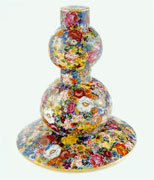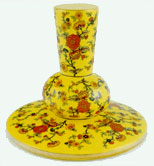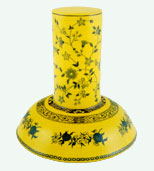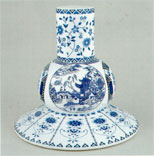Singular Abstractions Absolutely Recent Ceramics
by Léopold L. Foulem
January 25 - April 05, 2001
In this new series of ceramics: Singular Abstractions, the inherent volume constituting the essence of containers has not only been transformed into an undisputable mass, but also the resulting image has been unequivocally characterized by specific historical pottery surfaces.
Léopold Foulem, Third Annual Dorothy Perkins Lecturer
This absolutely recent body of work by Canadian ceramicist Leopold Foulem (b. 1945) being presented in this one-person exhibition in Alfred, is far from being an update on previous abstraction series exhibited in 1998 at Galerie Lieu Ouest, in Montreal, or in 1999 at Garth Clark Gallery in New York City.
Admittedly, at first glance, the reductive structural approach to form is somewhat similar. Here, also, emblematic pottery shapes have been appropriated and synthesized into three very basic geometric minimal forms: the sphere, the cone and the cylinder. Furthermore, the outside wall of the iconic three-dimensional structures is not monochromatic and the plinth has been taken away. The uniform single color of the earlier abstractions was stressing the connection with modernist high-art formalist consideration without, needless to say, obliterating the links with ceramic tradition such as Ming or Qing dynasties monochrome wares. The new surfaces are much more singular and overtly dissonant.
A major conceptual difference from the previous groups of abstractions is the disappearance of the ubiquitous plinth. That strategy was used to divorce the vessel form from its ordinary environmental space, thus creating a peculiar site for the object as image, and to accentuate the negation of function. However, in the Singular Abstractions series, this is achieved by exaggerating the proportion of the base on which rests the novel construction. This shift brings about a radical change in the reading of the piece at the formal aspect.
Now, at once, there are two distinct points of view presented to the viewer. The spatial relationship between the suggested or implied image and the physical object is to be understood as if one were looking at a perspective. The vertical architectonic form is in recession as if it were located quite far above the foot. The size of the horizontal disk, the base, is truly the actual dimension for reconstituting the true object.
The deliberate aloofness, the obvious distance between the maker, the medium and the finished piece is of capital importance. This maneuver neutralizes the hand-made aspect, the craft connection, and any sentimentality.

Abstraction 2001
("Hundred Flower"
Ground), 2000, ceramic, H:
11-1/4" (28.5 cm.) Diam:
10-1/4" (26.0 cm.),
courtesy of Garth Clark
Gallery, photo by Pierre
Gauvin.

Abstraction 2088(Yellow
Ground and Polychrome
Floral Motifs), 2000,
ceramic, H: 8" (20.0 cm.),
Diam: 8-1/8" (20.5 cm.),
courtesy of Garth Clark
Gallery, photo by Pierre
Gauvin.

Abstraction 2021 (Yellow
and Blue), 2000, ceramic,
H: 8-1/4" (21.0 cm.),
Diam: 8-1/8" (20.8 cm.),
courtesy of Garth Clark
Gallery, photo by Pierre
Gauvin.

Abstraction 2026 (Blue
Willow Pattern), 2000,
ceramic, H: 9-3/4" (25.0
cm.), Diam: 10-1/2" (26.5
cm.), courtesy Garth Clark
Gallery, photo by Pierre
Gauvin.